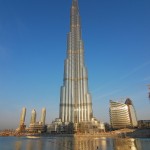By Geraldine Bedell www.guardian.co.uk
Dubai defies logic. Skyscrapers rear up out of the pitiless desert where, a generation ago, there was only wind-blown litter. This city-state confected from subsistence has now witnessed the opening of the world’s tallest building – the Burj Khalifa, steel-ribbed, glass-clad and completely unsustainable.

The 828m (2,717 foot) skyscraper boasts the world’s highest swimming pool and mosque and is said to contain enough glass to cover 17 football pitches. Not since 1311, when the spire of Lincoln Cathedral first topped the Great Pyramid of Giza, has the tallest structure in the world been located in the Arab world. Some Arabs, not unreasonably, interpret criticism of the building as resentment at Dubai’s presumption in setting itself up as a world city.
Stunningly designed by the Chicago firm of Skidmore, Owings and Merrell, the Burj Khalifa is inspired not only by minarets and desert flowers, but also by Frank Lloyd Wright’s 1956 plans for the Illinois Sky-City in Chicago. Neither the technology nor the money existed then to build such a structure. Now that it does, Dubai would like to see its audacious building as a metaphor for its role in the vanguard of globalisation, as a technocracy capable of yoking Islam and modernity.
The symbol, though, is already tarnished. Before and during construction, the building was called the Burj Dubai its website still is. The surrounding area was to have been known as Downtown Burj Dubai. But at Monday night’s launch, the name was abruptly changed to Burj Khalifa, in honour of the president of the United Arab Emirates and ruler of Abu Dhabi, Sheikh Khalifa bin Zayed al-Nahyan.
Last month, Abu Dhabi gave Dubai $10bn to stave off financial collapse. The name-change suggests the bailout may have come with conditions and that Dubai’s blander, richer neighbour may now exert some influence over its anything-and-everything-for-sale mentality.
In the space of one year, Dubai has gone from having the world’s best performing property market to one of the worst. The Burj Khalifa’s developers insist that 90% of its 900 apartments are sold and its 300,000 square feet of office space filled. In fact, most of the apartments were bought at the height of the market by speculators. And while a way may be found, for the sake of face, to occupy the office space, elsewhere in Dubai large tracts lie empty.
It is impossible to get accurate information about this; Dubai is an opaque place, where the line between government and private enterprise is blurred. What we do know is that little attention was paid in the boom years to the social or environmental consequences of development. All but 10% of the population of Dubai are expatriates, whose interests really lie elsewhere. The government featherbeds its few citizens but offers its majority of foreign inhabitants little more than a dream of making money, encouraging a short-term approach to the place. Certainly, it wants no political or civic engagement from them.
Many of Dubai’s construction workers live on starvation wages: £120 a month on average for a six-day week, with shifts of up to 12 hours. Housemaids can endure conditions approaching slavery.
Laws exist to regulate working conditions and to prevent employers from seizing workers’ passports, but they are not well enforced. Government figures are invariably owners, partners or shareholders in private companies. You only have to travel an hour into the desert to see the construction workers’ shanty towns to get a sense of what life is like for those who are building Dubai’s skyscrapers, but few do.
Construction workers on the Burj Khalifa have rioted on several occasions, including in March 2006, when 2,500 protested at the site, and again in November 2007.
A Human Rights Watch survey found a cover-up of deaths from heat, overwork and suicide in the emirate. The Indian consulate recorded 971 deaths of their nationals in 2005, after which they were asked to stop counting.
Meanwhile, the Burj Khalifa’s air-conditioning system is said to be the equivalent of melting 12,500 tons of ice a day, in a city that has the world’s highest per capita carbon footprint. Dubai relies heavily on CO2-emitting desalination plants. The Tiger Woods golf course alone requires 4m gallons of water a day. Short-term profits have repeatedly been put before sustainability.
There remains an outside chance that the emirate may yet become capable of combining development with equity, transparency and environmental sustainability.
But at the moment, Dubai is built entirely on a capitalism whose nakedness is clothed only in bling. And if that continues, the Burj Khalifa will stand as a symbol of a meretricious, credit-fuelled era in which no one with any choice would wish to live.













